Recommended Books
Grades K-3 – Korea
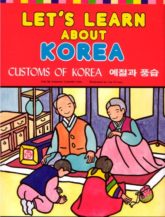
Let's Learn About Korea
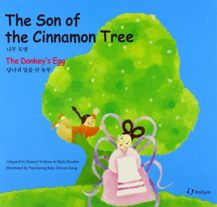
The Son of the Cinnamon Tree/the Donkey's Egg (Korean Folk Tales for Children, Vol 10)
Two charming folktales are included in this one bilingual (Korean and English) volume. 1) A cinnamon tree and his human son rely on each other as they set out on a series of adventures which occur at the time fo the great flood. 2) The hilarious story of a simple-minded farmer who buys a “donkey egg” from a clever watermelon vendor. Vol. 10 in the 10 volume set Korean Folk Tales for Children
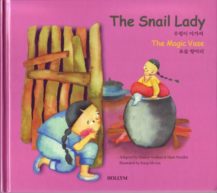
The Snail Lady/The Magic Vase (Korean Folk Tales for Children, Vol 6) (Korean Folk Tales for Children, Vol 6) (Korean Folk Tales for Children, Vol 6)
Two charming folktales are included in this single volume. Bilingual (English and Korean). 1) A king steals the beautiful Snail Lady away from her husband, the farmer. He must then defeat the king in a series of contests in order to obtain the return of his wife. 2) A fisherman finds a magical vase floating on the sea. It brings him good fortune, but it gives nothing but bad luck to his greedy wife. Volume 6 of the 10-volume set Korean Folktales for Children.
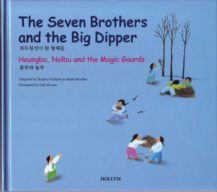
Seven Brothers & the Big Dipper and Hungbu, Nolbu and the Magic Gourds (Korean Folk Tales for Children, Vol 4)
Two charming tales are included in this single volume. Bilingual: English and Korean. 1) The Seven Brothers and the Big Dipper brothers help their widowed mother with such devotion that they become the seven stars in the Big Dipper. 2) Two brothers, one kind-hearted and one mean, plant some gourd seeds that were brought to them by a bird. When the gourds are opened, they reveal the difference between the fruits of greed and compassion. Volume 4 in the 10-volume set Korean Folktales for Children.
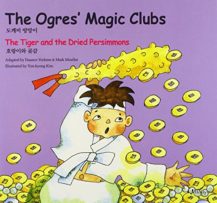
The Ogres' Magic Clubs/ The Tiger and the Dried Persimmons (Korean Tolk Tales for Children, Vol 5) (Korean Folk Tales for Children)
Vol. 5 in the 10 volume set Korean Folk Tales for Children. 2 charming stories are included in one bilingual (English and Korean) volume. 1) A kind brother and his evil older brother steal some magic clubs from some ogres. 2) The humorous tale of a tiger who loses his courage when he overhears a conversation about dried persimmons and imagines them to be a frightful monster.
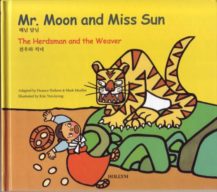
Mr. Moon and Miss Sun: The Herdsman and the Weaver (Korean Folk Tales for Children, Vol 2)
Two charming folktales are included in this single volume. Bilingual: English and Korean. 1) A young boy and his sister must escape from a tiger pretending to be their mother. They climb a rope to heaven where they become Mr. Sun and Miss Moon. 2)The sad story of the herdsman and the weaver who were allowed to see each other only once a year as punishment for not doing their work. Volume 2 of the 10-volume set Korean Folktales for Children
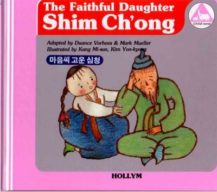
The Faithful Daughter Shim Chong The Little Frog Who Never Listened (Korean Folk Tales For Children) The Faithful Daughter Shim Chong The Little Frog Who Never Listened
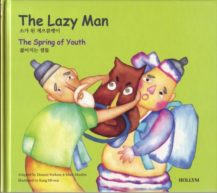
The Lazy Man / The Spring of Youth (Korean Folk Tales for Children, Vol. 3) (Korean Folk Tales for Children, Vol 3)
Two charming folktales are included in this single bilingual (English/Korean) volume: 1) The humorous tale of a lazy man who is transformed into an ox and comes to learn the value of hard work. 2) The timeless tale of people’s never-ending search for immortality. This is book #3 from the 10-volume series Korean Folk Tales for Children.
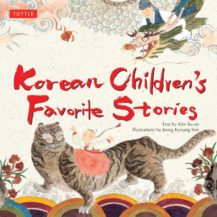
Korean Children's Favorite Stories
This colorfully illustrated multicultural Korean children’s book presents Indian fairy tales and other folk stories—providing insight into a vibrant literary culture.
Korean Children’s Favorite Stories is a captivating collection of Korean folktales for children which are still being told, just as they have been for generations. Some are Korean-specific, while others echo those told in other countries. Written with wit and pathos, they unveil the inevitable foibles of people everywhere and expose the human-like qualities of animals and the animal-like qualities of humans.
These Korean fables pulsate with the rhythm of life and the seasons, transporting the reader to a wonderland where ants talk, a baby rabbit outwits a tiger, a tree fathers a child, and a toad saves a whole village.
Korean stories include:
- The Story Bag
- The Pheasant, the Dove, and the Magpie
- The Bridegroom’s Shopping
- The Bad Tiger
- The Great Flood
- The Pumpkin Seeds
- The Grateful Tiger
- The Three Princesses
- And more…
The Children’s Favorite Stories series was created to share the folktales and legends most beloved by children in the East with young readers of all backgrounds in the West. Other multicultural children’s books in this series include: Asian Children’s Favorite Stories, Indian Children’s Favorite Stories, Indonesian Children’s Favorite Stories, Japanese Children’s Favorite Stories, Singapore Children’s Favorite Stories, Filipino Favorite Children’s Stories, Favorite Children’s Stories from China & Tibet, Chinese Children’s Favorite Stories, Balinese Children’s Favorite Stories, and Vietnamese Children’s Favorite Stories.
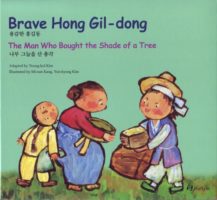
Brave Hong Gil-Dong/the Man Who Bought the Shade of a Tree (Korean Folk Tales for Children, Vol 8)
Vol. 8 in the 10 vol. set: Korean Folktales for Children. Two folktales are included in this one bilingual (English/Korean) volume. The first story is about Brave Hong Kil-dong, a commoner, who becomes a chivalrous and well-educated leader of a band of men and works for the cause of justice – a Korean Robin Hood. A greedy man makes a young man pay money for a tree’s shade. But he soon learns the shade is much more valuable than the greedy man had ever imagined.

Woodcutter and the Heavenly Maiden Korean (Korean Folk Tales for Children, Vol 1)
Two charming folk tales are included in this single volume. Bilingual (English and Korean). 1) A woodcutter longs for his children and fairy maiden wife in heaven and tries to follow them. 2) The fire dog embarks on a quest to bring back the sun and the moon so that the dark kingdom will have light. Volume 1 of the 10-volume set Korean Folk Tales for Children
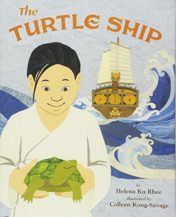
The Turtle Ship
Long ago in Korea, a young boy named Sun-sin spent his days playing with his pet turtle Gobugi and dreaming of sailing around the world. As a poor villager, though, his dream to travel seemed impossible. Then one day, the king s court announced a contest to find the best design for a new battleship to defend the land from invaders. The winner would sail the ocean with the royal navy.
Determined to win, Sun-sin attempts to build an indestructible battleship with a few found items. Each attempt fails miserably against the powerful sea, and with it Sun-sin s dream also sinks to the bottom. Turning to Gobugi for comfort, Sun-sin notices how his pet turtle is small but mighty, slow but steady, and impossible to sink. Suddenly, Sun-sin has a great idea.
Loosely based on the true story of Admiral Yi Sun-sin and his Turtle Ship, this delightful tale by debut author Helena Ku Rhee and debut illustrator Colleen Kong-Savage introduce young readers to a fascinating episode in Korean history and naval engineering.
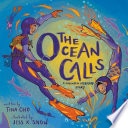
The Ocean Calls: A Haenyeo Mermaid Story
A breathtaking picture book featuring a Korean girl and her haenyeo (free diving) grandmother about intergenerational bonds, finding courage in the face of fear, and connecting with our natural world. Dayeon wants to be a haenyeo just like Grandma. The haenyeo dive off the coast of Jeju Island to pluck treasures from the sea–generations of Korean women have done so for centuries. To Dayeon, the haenyeo are as strong and graceful as mermaids. To give her strength, Dayeon eats Grandma’s abalone porridge. She practices holding her breath while they do the dishes. And when Grandma suits up for her next dive, Dayeon grabs her suit, flippers, and goggles. A scary memory of the sea keeps Dayeon clinging to the shore, but with Grandma’s guidance, Dayeon comes to appreciate the ocean’s many gifts. Tina Cho’s The Ocean Calls, with luminous illustrations by muralist Jess X. Snow, is a classic in the making.
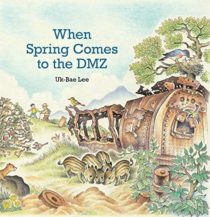
When Spring Comes to the DMZ
This unique picture book invites young readers into the natural beauty of the DMZ, where salmon, spotted seals, and mountain goats freely follow the seasons and raise their families in this 2.5-mile-wide, 150-mile-long corridor where no human may tread. But the vivid seasonal flora and fauna are framed by ever-present rusty razor wire, warning signs, and locked gates – and regularly interrupted by military exercises that continue decades after a 1953 ceasefire in the Korean War established the DMZ.
Creator Uk-Bae Lee’s lively paintings juxtapose these realities, planting in children the dream of a peaceful world without war and barriers, where separated families meet again and live together happily in harmony with their environment. Lee shows the DMZ through the eyes of a grandfather who returns each year to look out over his beloved former lands, waiting for the day when he can return. In a surprise foldout panorama at the end of the book the grandfather, tired of waiting, dreams of taking his grandson by the hand, flinging back the locked gates, and walking again on the land he loves to find his long-lost friends.
When Spring Comes to the DMZ helps introduce children to the unfinished history of the Korean Peninsula playing out on the nightly news, and may well spark discussions about other walls, from Texas to Gaza.
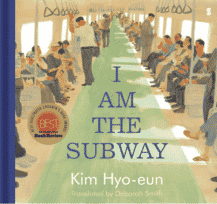
I Am the Subway
A cinematic journey through the Seoul subway that masterfully portrays the many unique lives we travel alongside whenever we take the train. A poetic translation of the bestselling Korean picture book.
